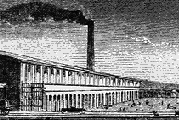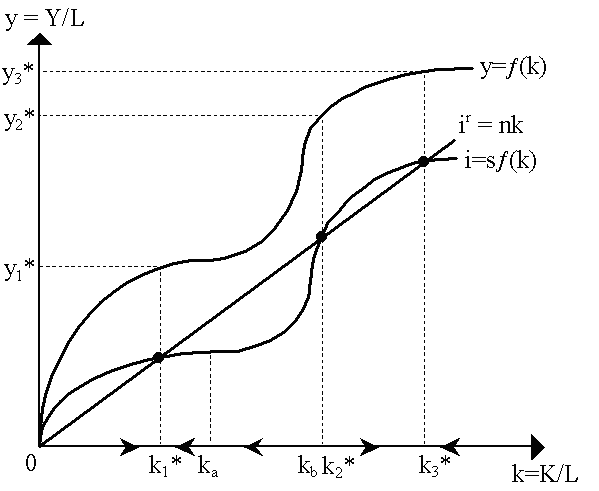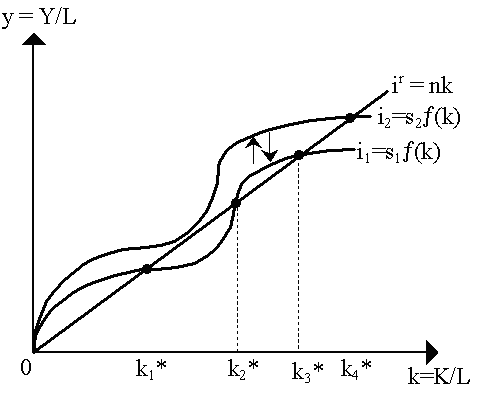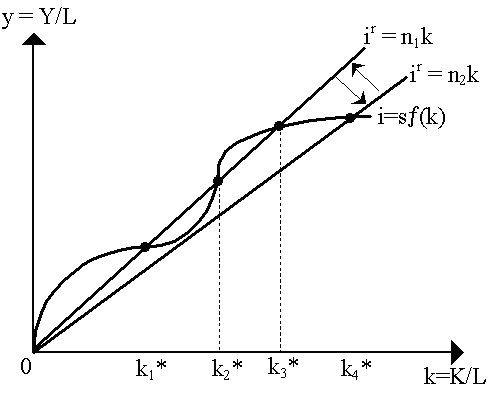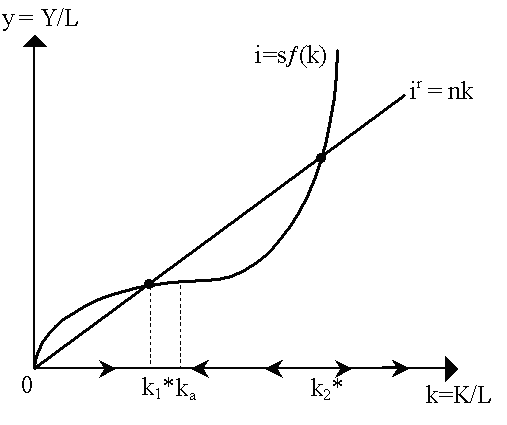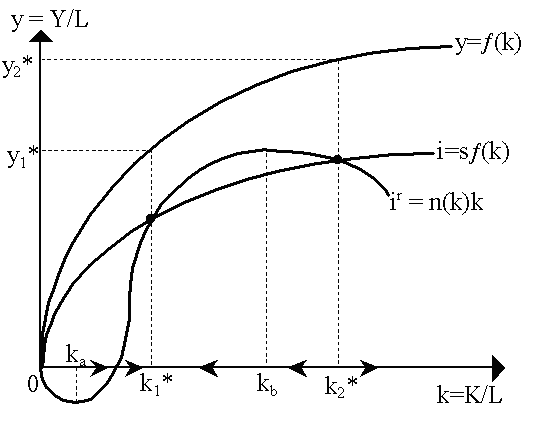|
Contents (1) The Technological Trap On the whole, the convergence hypotheses do not do very well empirically. As such, growth theorists have searched for ways of modifying the Solow-Swan growth model to explain why some countries do so well and others do so poorly. One of the favorite methods is by arguing that the difference can be explained by technological progress, exogenous or endogenous. However, technological change is not the only explanation. One set of stories that caught on quite early was the idea of poverty traps. In a sense, these are the exact opposites of the convergence hypotheses. They try to explain, within a Solow-Swan growth model, why some countries exhibit stagnant growth (i.e. growth with low-levels of income per capita) while others race on ahead. There are two types of poverty traps: technologically-induced poverty traps and demographically-induced poverty traps. We shall consider each of them separately. Both cases involve the inclusion of a non-linearity into the system. Both, incidentally, were considered by Robert Solow (1956). (1) The Technological Trap In the 1940s, it was quickly realized that poor nations are poor, that they are already saving what they can and still do not seem able to "accelerate" anything. A consensus emerged that underdeveloped countries might be caught in a "poverty trap", a vicious circle of low savings and few investment opportunities. How can this be explained? Allyn Young (1928) recalled Adam Smith's old idea about how the "division of labor is limited by the extent of the market". Dynamized into a growth context, this highlights the importance of externalities and increasing returns to scale in generating and sustaining an accelerated rate of growth. Nations that did not manage to achieve increasing returns were left behind. Those that did would "take-off" into ever-increasing standards of living. Paul Rosenstein-Rodan (1943, 1961), Hans Walter Singer (1949), Ragnar Nurkse (1953), Gunnar Myrdal (1957) and Walt Whitman Rostow (1960) appropriated this idea for development theory. They argued that increasing returns only set in after a nation has achieved a particular threshold level of output per capita. Poor countries, they argued, were caught in a poverty trap because they had been hitherto unable to push themselves above that threshold. In contrast, successful developing nations had benefited, at some earlier point, from a massive and wide-spread injection of capital, just enough to push them over the threshold and thereafter to "take-off". Their policy recommendations for underdeveloped nations therefore focused on recreating this Big Push artificially, whether by inflows of foreign capital or debt-financed government investment. We can capture this idea in a Solow-Swan model by allowing for non-linearities in the production function. Specifically, the argument is that the production function ¦ (·) has a middle portion where it exhibits increasing returns to scale, i.e.
Thus, the production function exhibits increasing returns to scale between critical values ka and kb Otherwise, there are constant returns. The result is depicted in Figure 1.
The features of the technological trap can be read from the diagram directly. We have four steady-states -- 0, k1*, k2* and k3*. Of these, k1* and k3* are stable, while 0 and k2* are unstable. The implication is that if a country begins with a capital labor ratio that is below k2*, then it will inexorably approach the stagnant steady-state ratio k1*. If its initial capital-labor ratio is above k2*, then it will approach the much better steady-state k3*. The ratio k2*, then, is the "threshold" which a nation has to reach to "take-off" and achieve the higher steady-state. Here is where the "Big Push" story comes in. It is argued that developed nations had, at some point in their history, a "Big Push" in terms of massive capital investment (or a demographic collapse) which pushed them over the k2* edge, which then, by the regular forces of the Solow-Swan model, drove them further up to the high k3* steady-state. Underdeveloped nations failed to experience this "Big Push" and so remained stuck in the orbit of k1*. It is not that they did not try, of course. Efforts by developing nations to push the capital-labor ratio up with public and private investment schemes did not work simply because these were not bold enough. They might have pushed themselves above k1*, but not enough to cross over the k2* threshold. For this to happen, a really big "Big Push" is needed. There are a few alternative policy options for stagnant nations in light of the technological trap. The first is that temporarily increasing the savings rate might actually serve as a policy option in this case. Specifically, consider Figure 2 and suppose that we have a country with savings rate s1 stuck at the stagnant steady-state ratio k1*. In order to manipulate itself into a Big Push, a rise in the savings rate from s1 to s2, will result in a situation where there is only one stable steady-state ratio -- the very high k4* in Figure 2. Maintaining the s2 savings rate for a while, the nation will enjoy a rapid rise in the capital-labor ratio from k1* towards k4*. However, it need not maintain this savings rate forever. Once the capital-labor ratio has gone past k2*, it can lower the savings rate back down to s1, and now the country is within the orbit of the high capital-labor ratio, k3*, and will move inexorably towards it by the standard properties of Solow-Swan adjustment. Thus, a temporary rise in the savings rate is one way for a nation to pull itself out of the technological trap.
Another way of escaping the technological trap is to temporarily lower the population growth rate. This is depicted in Figure 3. A nation stuck at k1* could swing the ir curve downwards by decreasing population growth from n1 to n2 temporarily, thereby leaving the very high k4* as the only steady-state ratio. The old population growth can be safely restored once the Solowian dynamics naturally pushed the economy over k2*.
One disappointing feature of the technological trap model is that, in the end, different countries may be at different steady-state ratios, but they still exhibit identical growth rates. In other words, in Figure 1, a poor economy at steady-state k1* and a rich economy at steady-state k3* would still experience the same growth rates of level variables and no growth in per capita variables. In a way, then, this result is similar to the conditional convergence case. This result can be easily circumvented if, following the arguments of the early development theorists, we decide to simply omit the upper diminishing returns portion of the production function, i.e. if we posit that:
as shown in Figure 4. In this case, increasing returns hold from ka onwards.
The consequence of this modification is that once a nation passes over the k2* threshold, it will grow forever. Thus, now, a poor nation is trapped in the sense that it will be stuck at its low steady-state and experience no growth in per capita ratios (the true meaning of "stagnation"), while a rich country's per capita income, constrained by no steady-state at all, will continue rising forever after. In this kind of situation, there is no "convergence" of growth rates between poor and rich nations. (2) The Population Trap Another interesting kind of poverty trap is the one induced by population. This is a variation on the canonical model which has interesting lessons for development because it generates a poverty trap without having to assuming anything about technology. In the Solow-Swan model, the rate of population growth was given exogenously. However, recall that in Classical models of growth, population growth is endogenous. Following Robert Malthus (1798), it was posited that the rate of growth of population is dependent on income per capita. Specifically, as income per capita rises, then the population growth rate rises. This is known as the Malthusian theory of demographic transition. Solow (1956) introduced the Malthusian demographic transition into his model. He followed the Classicals in allowing that when income per capita was very low, then population declined i.e. n was negative. But as income per capita increases, population growth would increase. Solow topped off the story by also accounting for fertility declines at very high income per capita. As population growth n is a function of y and y = ¦ (k), then population is indirectly function of the capital-labor ratio, i.e. n = n(k). We can summarize the demographic relationship by defining critical values ka and kb, where:
The implications of this demographic transition is that we obtain a non-linear required investment curve, ir = n(k)k as depicted in Figure 5. Beginning from the origin, we see that population declines until ka, after which it begins to increase, initially at an increasing rate, and then at a decreasing rate, until it hits kb, after which population begins to decline again.
Notice that in Figure 5, we have three steady-state equilibria: 0, k1* and k2*. However, of these, only k1* is stable; the origin and k2* are both unstable. Thus, for any capital-labor ratio between 0 and k2*, the system will tend to bring it back to k1*. Once again, the interesting implication is if, by some "Big Push", the economy can be elevated to a capital-labor ratio above k2*, then there will be a constantly increasing income per capita thereafter. In this demographic transition model, we do not have convergence in levels or growth rates between poor and very rich countries. The Malthusian "population trap" story was emphasized in development theory by Harvey Leibenstein (1954, 1957) and R. Nelson (1956). However, we should note that, empirically, there is no relationship between population growth and income per capita. More precisely, it is argued that this relationship is no longer valid because of national and international health efforts of the past few decades have helped push down the death rates and improved birth rates in underdeveloped countries. So, even if this story could explain past experience, it is not really "policy-effective" anymore. If anything, population growth is today more correlated with income distribution rather than income levels.
|
All rights reserved, Gonçalo L. Fonseca

